Related Research Articles
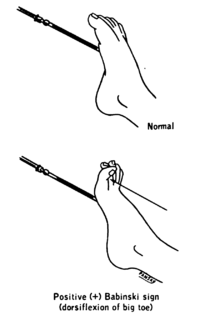
The plantar reflex is a reflex elicited when the sole of the foot is stimulated with a blunt instrument. The reflex can take one of two forms. In healthy adults, the plantar reflex causes a downward response of the hallux (flexion). An upward response (extension) of the hallux is known as the Babinski response or Babinski sign, named after the neurologist Joseph Babinski. The presence of the Babinski sign can identify disease of the spinal cord and brain in adults, and also exists as a primitive reflex in infants.
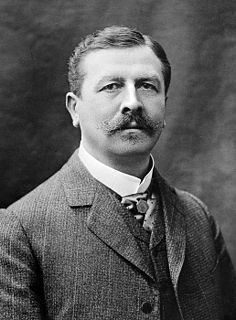
Joseph Jules François Félix Babinski was a French-Polish professor of neurology. He is best known for his 1896 description of the Babinski sign, a pathological plantar reflex indicative of corticospinal tract damage.
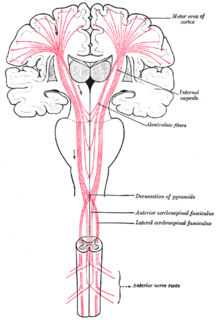
An upper motor neuron lesion Is an injury or abnormality that occurs in the neural pathway above the anterior horn cell of the spinal cord or motor nuclei of the cranial nerves. Conversely, a lower motor neuron lesion affects nerve fibers traveling from the anterior horn of the spinal cord or the cranial motor nuclei to the relevant muscle(s).

Gonda district is one of the districts of Uttar Pradesh, India. The city of Gonda is the district headquarters, and also the administrative centre for the Devipatan Division. The total area of Gonda district is 4,003 km2 (1,546 sq mi).
Hoffmann's reflex is a neurological examination finding elicited by a reflex test which can help verify the presence or absence of issues arising from the corticospinal tract. It is named after neurologist Johann Hoffmann. Usually considered a pathological reflex in a clinical setting, the Hoffmann's reflex has also been used as a measure of spinal reflex processing (adaptation) in response to exercise training.
The Chaddock reflex is a diagnostic reflex similar to the Babinski reflex. Chaddock's sign is present when stroking of the lateral malleolus causes extension of the great toe, indicating damage to the corticospinal tract.
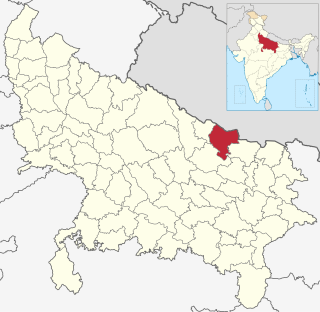
Balrampur district is one of the district of the Indian state of Uttar Pradesh and is a part of Devipatan division as well as the historic Awadh regions. It has been cut from the adjacent district Gonda in 1997. Located on the banks of the West Rapti River. Balrampur is known for the temple of Pateshwari Devi, a Shakti Pitha, and for the ruins of the nearby ancient city of Sravasti, now a pilgrimage site for Buddhists and Jains. The nearest airport is Shravasti airport 23.3 kilometres (14.5 mi) from the town but it is not an international and regular airport; the nearest international and regular airport is Chaudhary Charan Singh International Airport in Lucknow, 177.1 kilometres (110.0 mi) away. Lucknow is the capital city of Uttar Pradesh and is 162 kilometres (101 mi) from Balrampur district headquarters.
Oppenheim's sign is dorsiflexion of the great toe elicited by irritation downward of the medial side of the tibia. It is one of a number of Babinski-like responses.The sign's presence indicates a damage to the pyramidal tract.

Poltava is a narrative poem written by Aleksandr Pushkin in 1828–29 about the involvement of the Ukrainian Cossack hetman Ivan Mazepa in the 1709 Battle of Poltava between Sweden and Russia. The poem intertwines a love plot between Mazepa and Maria with an account of Mazepa's betrayal of Tsar Peter I and Peter's victory in battle. Although often considered one of Pushkin's lesser works and critiqued as unabashedly imperialistic, a number of critics have praised the poem for its depth of characterization and its ability to synthesize disparate genres. The poem inspired Tchaikovsky's 1884 opera Mazeppa.

Charles Gilbert Chaddock (1861–1936) was an American neurologist remembered for describing the Chaddock reflex.
Stransky's sign is a clinical sign in which vigorous abduction followed by the sudden release of the little toe causes an extensor plantar reflex. It is found in patients with pyramidal tract lesions, and is one of a number of Babinski-like responses.
Cornell's sign is a clinical sign in which scratching along the inner side of the extensor hallucis longus tendon elicits an extensor plantar reflex. It is found in patients with pyramidal tract lesions, and is one of a number of Babinski-like responses.
Gordon's sign is a clinical sign in which squeezing the calf muscle elicits an extensor plantar reflex. It is found in patients with pyramidal tract lesions, and is one of a number of Babinski-like responses.
Moniz sign is a clinical sign in which forceful passive plantar flexion of the ankle elicits an extensor plantar reflex. It is found in patients with pyramidal tract lesions, and is one of a number of Babinski-like responses.It is named after Portuguese neurologist António Egas Moniz.
Strümpell's sign is a clinical sign in which the patient's attempt to flex the knee against resistance elicits an extensor plantar reflex. It is found in patients with pyramidal tract lesions, and is one of a number of Babinski-like responses.
Throckmorton's reflex is a clinical sign in which pressure over the dorsal side of the metatarsophalangeal joint of the big toe elicits a plantar reflex. It is found in patients with pyramidal tract lesions, and is one of a number of Babinski-like responses.
Rossolimo's sign is a clinical sign in which percussion of the tips of the toes causes an exaggerated flexion of the toes. It is found in patients with pyramidal tract lesions, and is one of a number of Babinski-like responses.The sign is named after Grigory Ivanovich Rossolimo.
Schaeffer's sign is a clinical sign in which squeezing the Achilles tendon elicits an extensor plantar reflex. It is found in patients with pyramidal tract lesions, and is one of a number of Babinski-like responses.
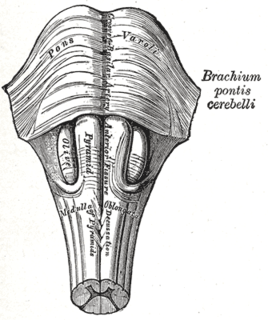
Babinski–Nageotte syndrome is an alternating brainstem syndrome. It occurs when there is damage to the dorsolateral or posterior lateral medulla oblongata, likely syphilitic in origin. Hence it is also called the alternating medulla oblongata syndrome.
Gondiya may refer to:
References
- ↑ Kumar SP, Ramasubramanian D (December 2000). "The Babinski sign--a reappraisal". Neurol India. 48 (4): 314–8. PMID 11146592 . Retrieved 2009-04-13.